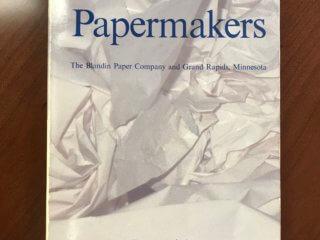 Image: History-circa1916-1927-ICHS2011.410.010CD42-mr_blandin_as_stpaul_newspaper_owner_and_paper_mill_owner
Image: History-circa1916-1927-ICHS2011.410.010CD42-mr_blandin_as_stpaul_newspaper_owner_and_paper_mill_owner
Our Founder
Schoolteacher, newspaperman, entrepreneur, philanthropist. Highlights from the life of founder Charles K. Blandin.
The legacy of Charles K. Blandin stems from a childhood marked with deep poverty, hard work, progress, business success and more. It’s a life story that culminated in a deep relationship with Grand Rapids, Minnesota – the community that was both home to the paper mill that bore his name, as well as the place to which he was personally committed. Upon his death, Mr. Blandin wished that his considerable and hard-earned assets be used to perpetuate the betterment of rural communities, especially the Grand Rapids area.
The son of a Wisconsin farmer, Charles K. Blandin was an entrepreneur before age 12. He turned a part-time job at a weekly newspaper into an apprenticeship and, eventually, a career in publishing. A self-educated and self-reliant man, he adhered to the principle be progressive, try new things. In his lifetime, Mr. Blandin taught school, ran several weekly newspapers, managed a successful metropolitan daily, and engineered the growth of a highly profitable, world-class paper mill in northern Minnesota.
Profits of the St. Paul Pioneer Press/Dispatch Printing Company rose impressively under Mr. Blandin’s management in the early 1900s. Shortly after purchasing the Itasca Paper Company in Grand Rapids, Minnesota in 1916, the Dispatch owner died; his widow offered Mr. Blandin half the company stock and a chance to manage the entire operation. Following her death, Mr. Blandin acquired the remainder of the stock and became owner of the mill. When newsprint production became unprofitable, he changed to ground wood papers and pioneered the manufacture of high-quality, coated stock. In 1927, Mr. Blandin sold the St. Paul newspapers, but not the paper mill. Two years later, its name was changed to the Blandin Paper Company.
Following the death of Mr. Blandin’s wife, Jennie, in 1940, he spent even more time in Grand Rapids, deepening his relationship with the community. To prepare for his company’s future and desire to serve the needs of the area after his death, Mr. Blandin established the Charles K. Blandin Foundation in 1941. He stipulated in his will that the foundation continue to perpetuate the distribution of company profits to community advantage. When Mr. Blandin died in 1958, the Foundation had assets of approximately $1 million. With investment of the proceeds from the sale of the mill in 1977, Mr. Blandin’s endowment for the foundation continues to grow exponentially.

